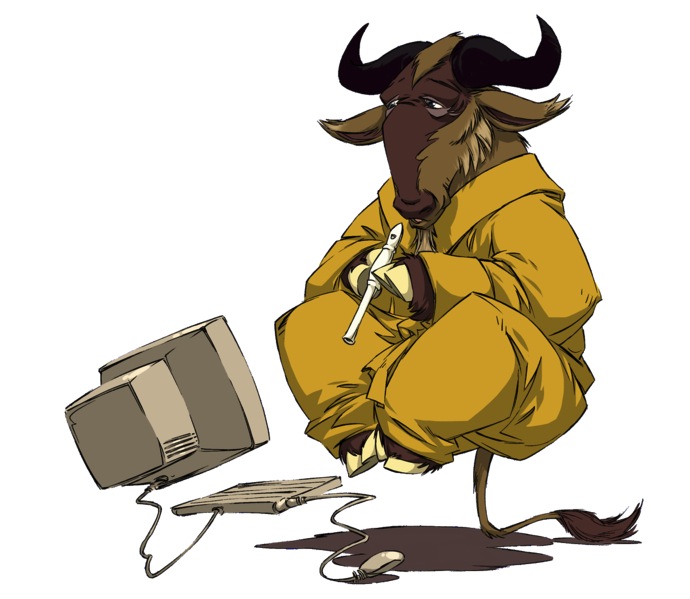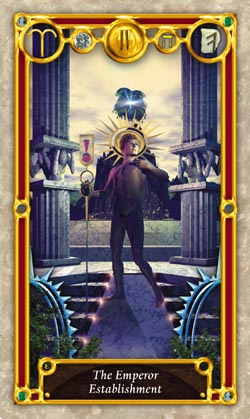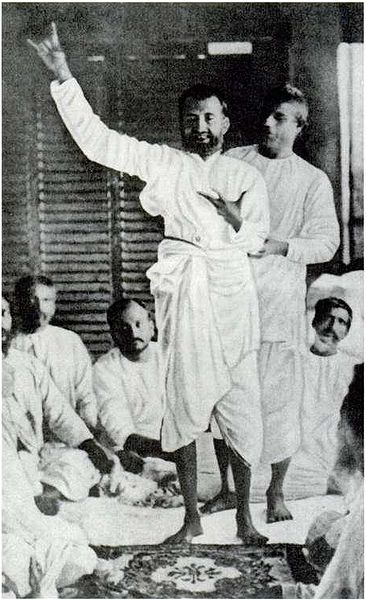Magick 101 #4: TRUE Meditation
[Part One of this Series: Click HERE] [Part Two of this Series: Click HERE] [Part Three of this Series: Click HERE]
People make a big deal over meditation. Unfortunately, there is more bad information about meditation than there is good. This is a shame, because it is a valuable and important technique for people learning magick.
 A levitating gnu, deep in meditation, wrapped snuggly in a gold robe.
A levitating gnu, deep in meditation, wrapped snuggly in a gold robe.
Both he and his computer float gracefully above the floor—only his tail lightly touches the ground.
He gently holds a recorder between his front hooves, as if he has just gotten the inspiration to play music.
There is a gleam in his eyes as he gazes ahead at his computer screen.
Debunkers, often looking at the claims that meditation can do things such as reduce stress and lower your blood pressure, note that by just relaxing with your feet up you can achieve the same things. That’s true, but meditation is far more than that.
Some debunkers, looking at dictionary definitions, say that meditation is just focusing on something in order to come up with new approaches and solutions to issues and challenges. That’s true, but meditation is far more than that.
True meditation has as its goal the ability to transcend your sense of individuality and separateness for a brief time, allowing you to experience your true higher self and unity with the universe…even unity with the Divine. Relaxation or contemplation are simply techniques on the road to that goal. But saying that either is meditation is like saying sex is nothing more than smiling at someone across the room!
The Stages of True Meditation
True meditation consists of three steps or stages.
 Yogic “Child’s Pose” (Balasana in Sanskrit)
Yogic “Child’s Pose” (Balasana in Sanskrit)
Stage One—Relaxation
The first stage of meditation is relaxation of mind and body. Relaxation of the mind begins by eliminating those things that bother you. This usually involves two things:
- Accepting a set of ethics based on honesty and personal responsibility, and
- Learning to focusing on the present rather than dwelling on the past (which can’t be changed) or worrying about the future (which is guessing about what might happen).
An important part of this is simply learning to breath as I discussed in part two of this series.
Relaxing the body traditionally involved practices such as hatha yoga, what most Westerners consider to be the extent of yoga. The photo above shows a woman in a pose known as the “Child’s Pose.” It’s considered by yoga practitioners to be rather simple, but to many Westerners just looking at it is uncomfortable! Actually assuming that position seems unlikely.
Luckily, there is something you can do to deeply relax your physical body. It is called progressive relaxation or progressive muscle relaxation. This system is taught in numerous systems and books and is often used as a beginning step in hypnotic inductions. Briefly, you simply “talk” to each part of your body and tell it to relax. When leading others in the practice of progressive relaxation I like to begin this way:
Get comfortable where you are, seated or lying on your back. Uncross your arms and legs and breathe normally. Now, imagine a sphere of brilliant, golden light, surrounding your feet. As you focus on your feet and that golden glow, all of the muscles in your ankles, feet, and toes just let go and totally, deeply, relax. You don’t have to do anything. When the sphere is there the muscles just relax and any tension fades away. If you notice any tightness or stress, just breathe and allow it to fade away.
Next, the golden glow moves up to your calves. The muscles of the calves simply become loose and totally relax. You don’t have to do anything, just let go. If you notice any tightness or stress in either of your calves, just breathe and allow it to fade away…
Continue this way up your legs, torso, arms, neck and head. Alternatively, you can start at the head and work down to the toes. When you are deeply relaxed using this system, spend a few minutes just breathing using the Complete Breath described in part two of this series.
When you combine these mental and physical practices of relaxation, you will take your attention away from the world and turn it inward. In Sanskrit, the language of Tantra, this is known as pratyahara, the withdrawal of the senses and the normal attention we pay to our environment.
Stage Two—Contemplation
 Hebrew Letter Alef
Hebrew Letter Alef
The second stage of meditation involves the intense focus of your mind on a single thing. This can be any object, picture, sound, activity, etc. Traditional examples of this include a sound (Sanskrit: mantra) or a symbolic image (Sanskrit: yantra). In the Kabalah, the Hebrew for this practice is Yih-chu-deem meaning “unifications.”
Another system for developing this intense concentration (Chaos magicians refer to such concentration as a “Gnostic Trance”) is the Kabalistic practice known as Black Fire on White Fire. Here is this technique:
- Cha-kee-kah or “Engraving”: Fix your gaze on an image. A popular choice for this was the use of a Hebrew letter such as Alef shown above. Do not take your eyes off of it. If your eyes water, that is fine. Let them
- Chatz-ee-vah or “Hewing”: Close your eyes and visualize what you were looking at, such as the Alef, as being made of black fire on a background of white fire.
- Let everything other than the image become white.
- Allow your thoughts to flow freely.
- Alternative: Visualize the image expanding until it becomes enormous. Treat it like a door and enter it.
 The Emperor from the Quest Tarot by Joseph Martin
The Emperor from the Quest Tarot by Joseph Martin
In Modern Magick I present a modified version of this system. In it you use a card from your favorite Tarot deck.
Scanning:
This is similar in nature to the method by which an old television with a large, heavy picture tube produces an image. In a picture tube is a device called an “electron gun” which shoots electrons in a small single beam toward the screen, forming a “scan line” across the front of the tube. The beam from the electron gun then jumps back to just below the first line and repeats the process*. If you look closely at the front of such a TV set when it is on you can see the lines. You cannot see the lines as they are made because the process is done so fast that your eye cannot follow it. This speed, combined with the way you mind holds onto a picture, is what gives the appearance that you have a solid and moving picture on your TV.
- Start by looking at the upper right hand corner of your chosen card.
- Look at a horizontal strip of the card about a half-inch in height, from the top of the strip to the bottom. Do your best to memorize what you see as you move your vision from right to left across the width of the card. Thus you should have a strip of the card in your mind composed of the uppermost half-inch of the card.
- Now return to the right-hand side of the card and scan again across the card, from right to left, covering another half-inch strip immediately below your previous scan.
- Repeat this process until you have totally covered the card.
What you are doing is memorizing the card, from top to bottom, a half-inch at a time. Try to remember as much of each strip or “scan” as you can, but don’t worry about perfection. You will get better with practice.
In the next part you will become fully involved with the object. Put simply, the technique is to reproduce the previous step of scanning, but within your mind’s eye.
- Put down the card so that you can no longer see its face.
- By memory, go through and visualize the entire scanning process.
Go one strip at a time until you have reproduced—in your imagination and to the best of your ability—the entire card. The first time you do this, and for many times to follow, you will probably miss many symbols, images, and colors, and perhaps you will only be able to recall and mentally create the outline of larger shapes that were on the card. It is not important that you are completely accurate with your visualization, but your visualization abilities will improve with this practice. This does not mean it’s okay to be lazy or overly brief in this process. Do the very best that you can. This step should take between three and four minutes, but if you wish it may take longer.
In Sanskrit, this phase of meditation is known as dharana.
Stage Three—Negation
 Ramakrishna (1836–1886) in samadhi, supported by his nephew and surrounded by devotees.
Ramakrishna (1836–1886) in samadhi, supported by his nephew and surrounded by devotees.
Photograph taken Sunday, Septembeer 21, 1879, in Calcutta (now Kolkata), India.
Leading to what is known as Dhyana or Samadhi in Sanskrit—True Meditation—the next stage is what I call “negation.”
- Starting again in the upper right-hand corner of the card which you have now visualized through the scanning procedure, take the topmost strip that you scanned and, moving from right to left, erase the image. That is, you “de-scan” it; you make that first and topmost strip disappear. In your mind’s eye you should still see a card, but with its top half-inch being removed.
- Return to the top right-hand corner of what is left of your visualized card and repeat the process, taking off another strip.
- Continue this de-scanning, erasing process until the entire card is gone from your mind. Duration for this step: about 1 1/2–3 minutes, maximum.
At this point, a very interesting phenomenon will occur. By the time the card is gone from your visualization your consciousness, which has been caught up in the act of scanning and de-scanning the visualized card, will also be “gone” (actually it will just be silent). The constant monologue in your head that is always going on while you are awake will be stopped. This will give your higher self, your link to the Divine, a chance to communicate with you and give you possibly important messages and information. The result is a wonderful state of bliss known as Samadhi, Nirvana or Cosmic Consciousness. It is a sensation of being at one with the universe, and there is nothing else like it.
When you first try this process, it is common for this state to last for only a brief moment. The inner voice returns and asks something like “Am I silent? Did I do this right?” As soon as the voice comes back, the meditation is over.
As you practice this technique you will be able to make that instant of True Meditation last a minute, five minutes, or more. As this state stretches out in length you will have a new feeling come over you, a feeling of being in total harmony with the universe, of having all knowledge and knowing that although things must evolve to a better state, all things are exactly as they should be at this instant in time. This is known as cosmic consciousness or enlightenment. In actuality it is really impossible to speak of this state of mind, feeling, and existence. You must experience it and discover its beauty for yourself.
Sooner or later you will probably come to realize that True Meditation should become a part of your daily life. If you choose to use another system of meditation than is described here, do not deceive yourself into thinking that you are really meditating if all you are doing is concentrating or relaxing. I’m not saying there aren’t other great techniques of meditation, only that they require variations of these three stages.
*Actually, it skips a line, but for this discussion that’s not important.








I’d be interested in knowing what gave you the idea that there is any such thing as “true meditation”? And if this post (which seems to be an expanded version of what you wrote in Modern Magick) represents “true meditation” then what do you make of other practices that use the term, like “mindfulness meditation” (which is neither “concentration” nor “relaxation”)?
What I described above is the classical interpretation of meditation presented in modern terminology and with contemporary methods. If you leave out steps, as many do, you may have something of quality…but it’s not true meditation. The words “meditation,” “Tantra,” “magick,” “Witchcraft,” “Quantum Physics,” etc., have in many cases become catch words that some people choose to use in order to link their own ideas to something with is familiar to others. Simply using the words may make something popular, but that does not actually link new concepts to the ancient ones. Personally, I think there’s nothing wrong with new things, new ideas, and new discoveries. Unfortunately, sometimes people seeking to popularize their ideas don’t see the validity in their own creations and try to attach it to something else.
I’ve worked at this method for a year and finally have experienced a few seconds of the peace you describe. It takes practice and persistence, but well worth it.
[…] a previous post I described what I referred to as “True Meditation.” I pointed out that real meditation […]